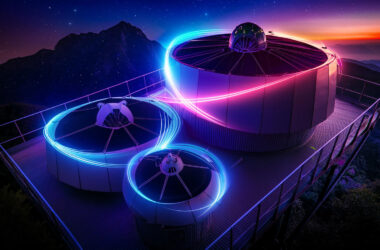SpaceX’s Starship program has been making significant strides in developing a fully reusable, super-heavy-lift launch vehicle capable of carrying crew and cargo to Earth orbit, the Moon, Mars, and beyond.
As the company prepares for the third high-altitude test flight of the Starship prototype, dubbed Flight 3, anticipation builds for the crucial milestones and technological advancements.
Weather is 70% favorable for today’s third integrated flight test of Starship.
The live webcast will begin ~30 minutes before liftoff, which is currently targeted for 7:30 a.m. CT → https://t.co/G1H8uoTxWD pic.twitter.com/uN3I9WBtKe
— SpaceX (@SpaceX) March 14, 2024
The Starship program has undergone a series of test flights, each providing valuable lessons and paving the way for further improvements. Flight 1, conducted with Booster 7 and Ship 24, encountered engine failures and pad damage. Despite not achieving all its objectives, the flight provided crucial data for enhancing the vehicle’s performance and reliability.
Flight 2, featuring Ship 25 and Booster 9, showcased notable upgrades, including improved engine shielding, upgraded Raptors with electric thrust vector control, and an enhanced fire suppression system. Although the flight ended with the loss of the booster and the premature activation of the flight termination system, it successfully demonstrated hot staging and nearly reached orbital velocity.
Building upon the lessons learned from previous flights, SpaceX has meticulously prepared for Flight 3. Booster 10 and Ship 28, the most advanced pair of vehicles to date, incorporate several key upgrades. Booster 10 features a simplified standard dome design and additional slosh baffles to mitigate propellant sloshing during the flip and boost backburn. Ship 28 boasts reinforced structures, optimized header tank vents, and a refined heat shield.
The launch pad at Starbase, Texas, has also undergone significant enhancements. Adding subcoolers and pumps to the propellant storage system has reduced propellant loading time from 97 minutes to 50 minutes. Integrating detank manifolds allows for faster detanking during testing or abort scenarios, reducing turnaround time between launch attempts.
Regulatory approvals and environmental assessments have been completed, with the Federal Aviation Administration (FAA) issuing a modification to Starship’s launch license for Flight 3. The environmental assessment for the new landing zone in the Indian Ocean has been approved, permitting up to ten launches.
Flight 3 aims to build upon the successes and lessons of the previous flights while attempting several ambitious objectives. These include the successful ascent burn of both stages, the opening and closing of Starship’s payload bay door, a propellant transfer demonstration during the upper stage’s coast phase, and the first-ever relight of a Raptor engine in space.
The flight will follow a new trajectory, with Starship targeted to splashdown in the Indian Ocean. This flight path allows SpaceX to attempt innovative techniques, such as in-space engine burns while prioritizing public safety.
SpaceX Starship Launch Timeline
The launch timeline for Flight 3 has been optimized based on the upgrades made to the propellant loading system. The propellant load for the Ship will commence 11 minutes before the booster propellant load, aiming to have both vehicles finish loading at nearly the same time.
SpaceX has outlined an ambitious 65-minute flight plan for Starship’s third test flight, which aims to demonstrate several new capabilities and technologies. Unlike the previous two attempts, which targeted the Pacific Ocean, Flight 3 will aim for the Indian Ocean.
The reduced flight time, down from 90 minutes in earlier plans, reflects SpaceX’s focus on testing specific aspects of the Starship system. It’s important to note that the previous two flights lasted less than 5 minutes each, highlighting the challenges and uncertainties inherent in the development process.
If all goes according to plan, the flight timeline will unfold as follows:
- Liftoff (T+0:02)
- Max Q (maximum dynamic pressure) (T+0:52)
- Booster Main Engine Cutoff (MECO) (T+2:42)
- Hot-staging (Starship Raptor ignition and stage separation) (T+2:44)
- Booster boostback burn startup (T+2:55)
- Booster boostback burn shutdown (T+3:50)
- Booster becomes transonic (T+6:36)
- Booster landing burn startup (T+6:46)
- Booster landing burn shutdown (T+7:04)
- Starship engine cutoff (T+8:35)
- Payload bay door opens (T+11:56)
- Propellant transfer demonstration (T+24:31)
- Payload bay door closes (T+28:21)
- Raptor in-space relight demonstration (T+40:46)
- Starship atmospheric entry (T+49:05)
- Starship becomes transonic (T+62:16)
- Starship becomes subsonic (T+63:04)
- Splashdown in the Indian Ocean (T+64:39)
This flight will test several key systems and maneuvers, including the separation of the Starship upper stage from the Super Heavy booster (known as “hot-staging”), the operation of the payload bay door, a propellant transfer demonstration, and an in-space relight of the Raptor engines.
The successful completion of these objectives would represent a significant step forward for the Starship program, providing valuable data and experience for future missions. However, given the challenges encountered in the first two test flights, it remains to be seen whether Starship will be able to complete its ambitious flight profile on this attempt.
SpaceX’s Starship Flight 3 represents a critical milestone in pursuing advanced space exploration technologies. By building upon the successes and challenges of previous flights, incorporating cutting-edge upgrades, and pushing the boundaries of what is possible, SpaceX is setting the stage for a new era of spaceflight.
TLDR (Too Long; Didn’t Read):
- SpaceX is set to conduct the third high-altitude test flight of its Starship spacecraft, aiming to build upon lessons learned from previous attempts.
- Booster 10 and Ship 28, featuring several key upgrades, will be used for Flight 3, targeting splashdown in the Indian Ocean.
- The flight will test crucial milestones, including hot staging, payload bay door operation, propellant transfer, and in-space Raptor engine relight.
- A successful Flight 3 would validate Starship’s design and pave the way for future missions to the Moon, Mars, and beyond.








